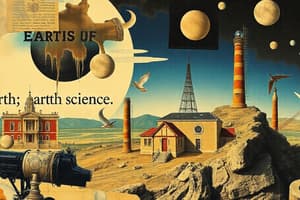Podcast
Questions and Answers
What is the definition of a fault line?
What is the definition of a fault line?
- A piece of Earth's crust that shifts
- A zone of high volcanic activity
- An area likely to cause geological problems (correct)
- A path connecting two larger landmasses
Which of the following countries is part of Mainland Southeast Asia?
Which of the following countries is part of Mainland Southeast Asia?
- Philippines
- Indonesia
- Vietnam (correct)
- Timor-Leste
What defines the absolute location of a place?
What defines the absolute location of a place?
- Its distance from nearby regions
- The cultural significance of the location
- Coordinates like latitude and longitude (correct)
- The position relative to other landmarks
Which latitude line divides the Earth into the Northern and Southern Hemispheres?
Which latitude line divides the Earth into the Northern and Southern Hemispheres?
Which feature characterizes the geographical location of Southeast Asia?
Which feature characterizes the geographical location of Southeast Asia?
Which of the following terms refers to land being surrounded by water?
Which of the following terms refers to land being surrounded by water?
What is the total land area of Southeast Asia?
What is the total land area of Southeast Asia?
Which tectonic plate is NOT one of the three major plates Southeast Asia is located in the middle of?
Which tectonic plate is NOT one of the three major plates Southeast Asia is located in the middle of?
Which Southeast Asian country has the absolute location of 21° N, 105.8° E?
Which Southeast Asian country has the absolute location of 21° N, 105.8° E?
What is the insular location of the Philippines to the north?
What is the insular location of the Philippines to the north?
What type of relative location refers to the nearby or adjacent areas?
What type of relative location refers to the nearby or adjacent areas?
Which country is located at the coordinates 4.9° N, 115° E?
Which country is located at the coordinates 4.9° N, 115° E?
Which of the following describes the position of Thailand relative to its nearby countries to the south?
Which of the following describes the position of Thailand relative to its nearby countries to the south?
Flashcards are hidden until you start studying
Study Notes
Definitions of Terms
- Tectonic plates are massive parts of the Earth's crust and upper mantle that constantly shift and interact.
- A fault line is a weak area on the Earth's surface where these plates meet, potentially causing seismic activity.
- An isthmus is a narrow strip of land connecting two larger landmasses.
- The Pacific Ring of Fire is a zone around the Pacific Ocean characterized by intense volcanic activity and earthquakes.
- The Circum-seismic Belt is a location marked by a high number of earthquakes, often overlapping with the Pacific Ring of Fire.
- Insular refers to something surrounded by water, specifically an island.
- Relative location describes a place's position in relation to its neighboring places.
- Absolute location defines a place's exact position using latitude and longitude coordinates.
Parts of the Globe or Map
- Latitude lines are imaginary circles that run horizontally across the Earth, indicating north and south directions.
- The Equator is the 0° latitude line that divides the Earth into the Northern and Southern Hemispheres.
- Longitude lines are imaginary circles that run vertically across the Earth, indicating east and west directions.
- The Prime Meridian is the 0° longitude line that divides the Earth into the Eastern and Western Hemispheres.
- The Tropic of Cancer is located at 23.5° N latitude.
- The Tropic of Capricorn is located at 23.5° S latitude.
Location of Southeast Asia
- Southeast Asia occupies 4.43 million square kilometers, representing almost 10% of the total Asian landmass.
- The region is situated south of mainland China, east of South Asia and the Bay of Bengal, and west of the Pacific Ocean.
- Mainland Southeast Asia comprises Myanmar, Thailand, Cambodia, Laos, and Vietnam.
- The Philippines, Indonesia, Malaysia, Brunei Darussalam, Singapore, and Timor-Leste make up the island portion of Southeast Asia.
- Southeast Asian countries are located between the Tropic of Cancer and Tropic of Capricorn, and along the equatorial line.
- Due to its tropical location, the region experiences warm temperatures year-round with abundant rainfall.
- Southeast Asia sits at the intersection of three major continental plates: Eurasia, Indian-Australian, and Pacific.
- This position makes the region part of the Pacific Ring of Fire and Circum-seismic Belt, resulting in numerous fault lines.
- The Philippines Fault Zone (PFZ) extends 1,200 kilometers from northwest Luzon to southeast Mindanao.
Absolute Location of Southeast Asian Countries
- Hanoi, Vietnam: 21° N, 105.8° E
- Naypyidaw, Myanmar: 19.8° N, 96° E
- Bangkok, Thailand: 13.8° N, 100.5° E
- Phnom Penh, Cambodia: 12.6° N, 105° E
- Vientiane, Laos: 18° N, 103° E
- Jakarta, Indonesia: 6° S, 106.8° E
- Kuala Lumpur, Malaysia: 3° N, 101° E
- Manila, Philippines: 15° N, 121° E
- Bandar Seri Begawan, Brunei Darussalam: 4.9° N, 115° E
- Singapore: 1.4° N, 103.8° E
- Dili, East Timor: 8.6° S, 125.6° E
The Relative Location of the Southeast Asian Countries
-
Vicinal Location describes the nearby or adjacent areas.
- Example: Thailand
- East: Laos
- West: Myanmar
- Southwest: Cambodia
- South: Malaysia
- Example: Thailand
-
Insular Location refers to the bodies of water surrounding a specific area.
- Example: The Philippines
- North: Bashi Channel, Luzon Strait
- East: Pacific Ocean, Philippine Sea
- West: West Philippine Sea
- South: Celebes Sea
- Example: The Philippines
Studying That Suits You
Use AI to generate personalized quizzes and flashcards to suit your learning preferences.




